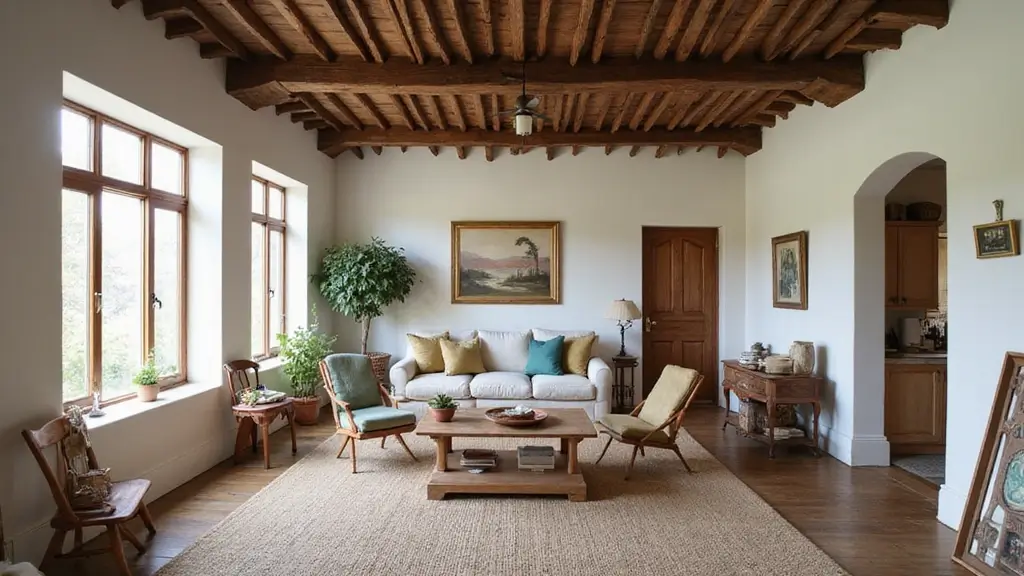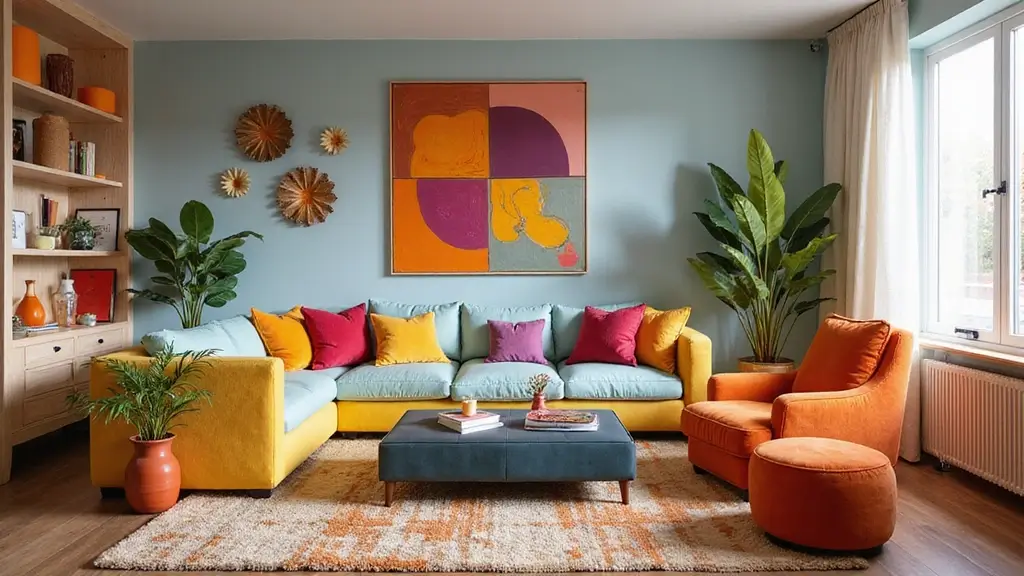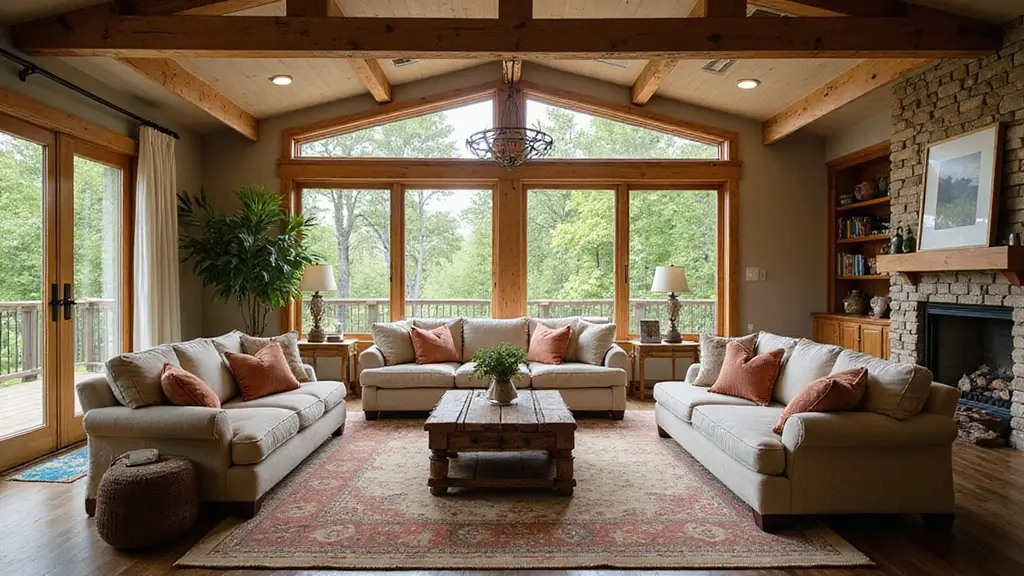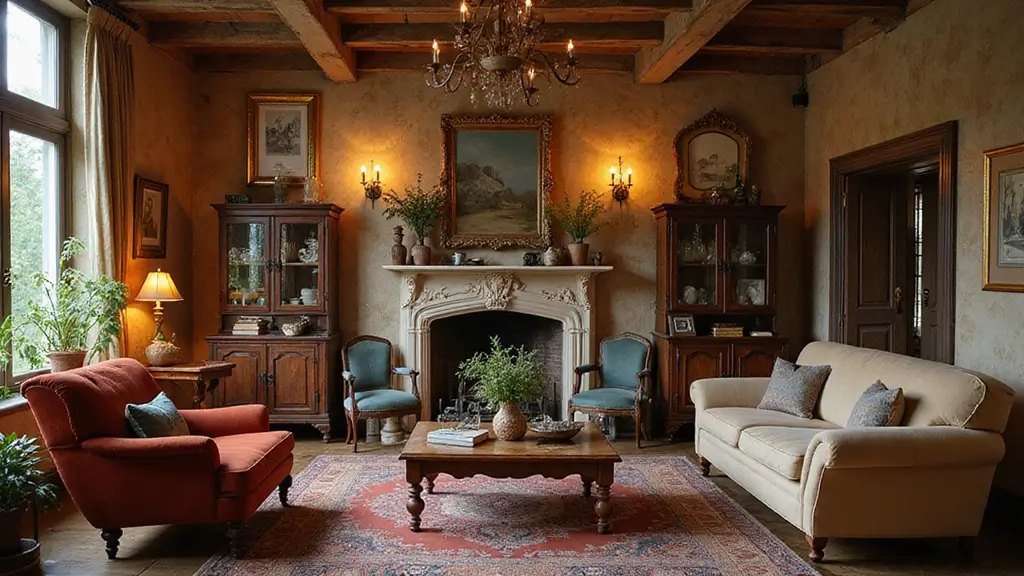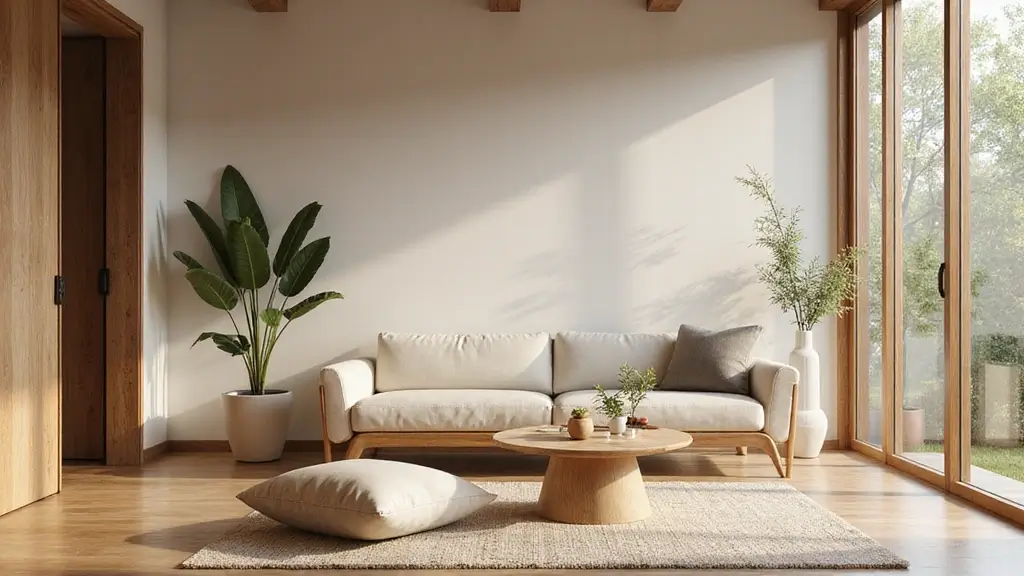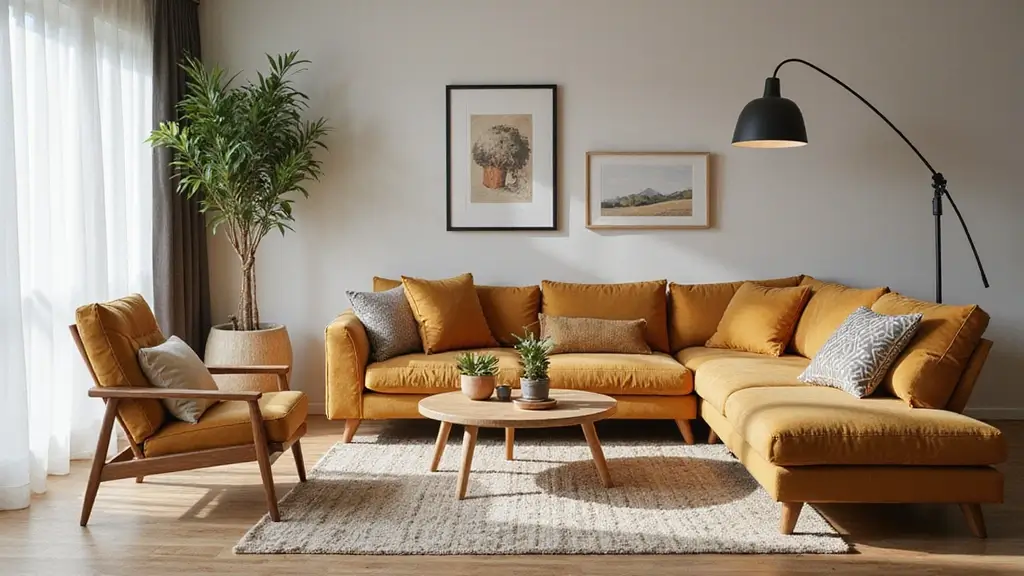Colonial houses are timeless treasures, steeped in history and offering a rich canvas for interior design.
Blending traditional elements with modern touches not only preserves the charm of these homes but also breathes new life into their spaces.
Incorporating sustainable practices in your design choices elevates the aesthetic while being environmentally friendly, making every room a reflection of your values and style.
From rustic accents to vintage furniture pieces, this list explores 42 ideas that strike the perfect balance between the old and the new, ensuring your colonial home decor is as stylish as it is sustainable.
1. Embrace Vintage Furniture

Vintage furniture is a cornerstone of colonial home decor. The unique character and craftsmanship of vintage pieces create a warm, inviting atmosphere. By incorporating items like an antique dining table, such as the Antique Style Dining Table, or a rustic sideboard like the Rustic Sideboard, you bring in history and charm that modern furniture often lacks.
Look for pieces that tell a story—perhaps a chest from the 1800s or a rocking chair that has seen generations. Combining these vintage finds with modern accents, like the Contemporary Light Fixture, can create a striking visual contrast that celebrates both past and present. This sleek light fixture can brighten your space while enhancing the overall aesthetic, providing a lovely juxtaposition to the rustic furniture.
Additionally, sourcing from local thrift shops or estate sales not only supports sustainable living but also ensures that your decor is unique. To maintain cohesion, think about using a similar color palette across your vintage and modern pieces, ensuring they complement rather than clash. Remember, the beauty of vintage furniture lies in its imperfections, embodying a narrative that enhances the overall aesthetic of your colonial home.
Vintage furniture tells a story that modern pieces often can’t. Embrace the charm of a rustic sideboard or an antique dining table to create a home that feels both inviting and timeless.
2. Mix Historical Colors with Modern Neutrals
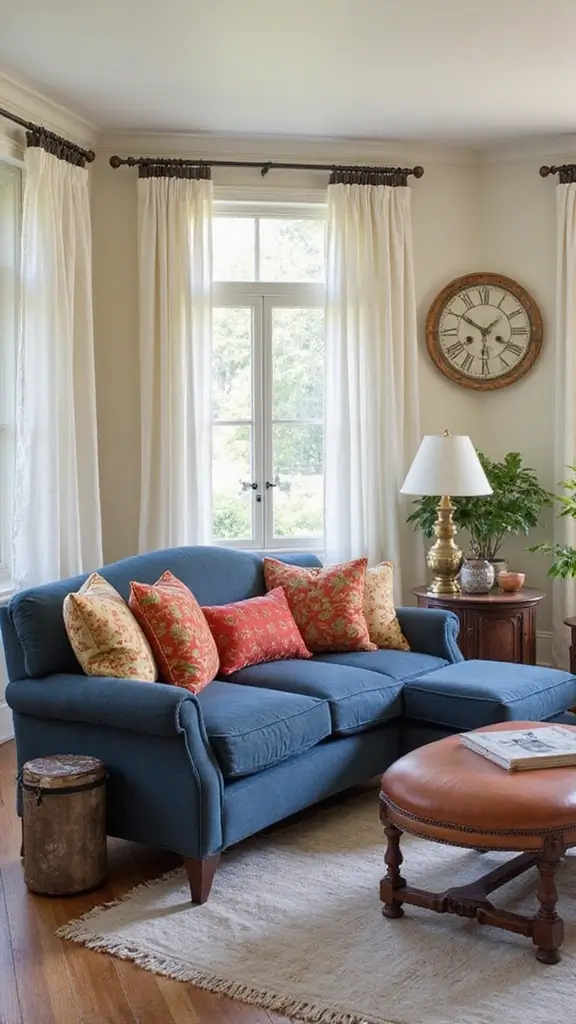
Color plays a vital role in unifying a colonial home design. Historical colors like deep blues, rich greens, and warm earth tones can be beautifully offset by modern neutrals such as whites, grays, and beiges. This combination creates a balanced, harmonious environment.
For example, consider painting your walls in a soft cream using Rodda Paint CASCADIA ZERO Interior Satin Low VOC Paint & Primer in One, Quart, Melting Glacier, and accentuating it with a deep navy sofa or emerald green throw pillows. The low-VOC formulation ensures that your choice is not only stylish but also eco-friendly, aligning with sustainable design practices.
To further enhance your space, incorporate textiles that introduce historical patterns while keeping the base colors modern and neutral. Decorative accents like throw pillows with historical patterns can infuse personality into your decor. The vintage floral block print adds a touch of classic charm, making your living area both inviting and visually stimulating.
Additionally, consider adding an area rug with classic prints to anchor your seating arrangement. This piece not only adds warmth but also introduces texture and a nostalgic element to the overall design. Remember, layering colors and textures thoughtfully can add depth and dimension, making your space feel both spacious and inviting.
3. Incorporate Rustic Accents
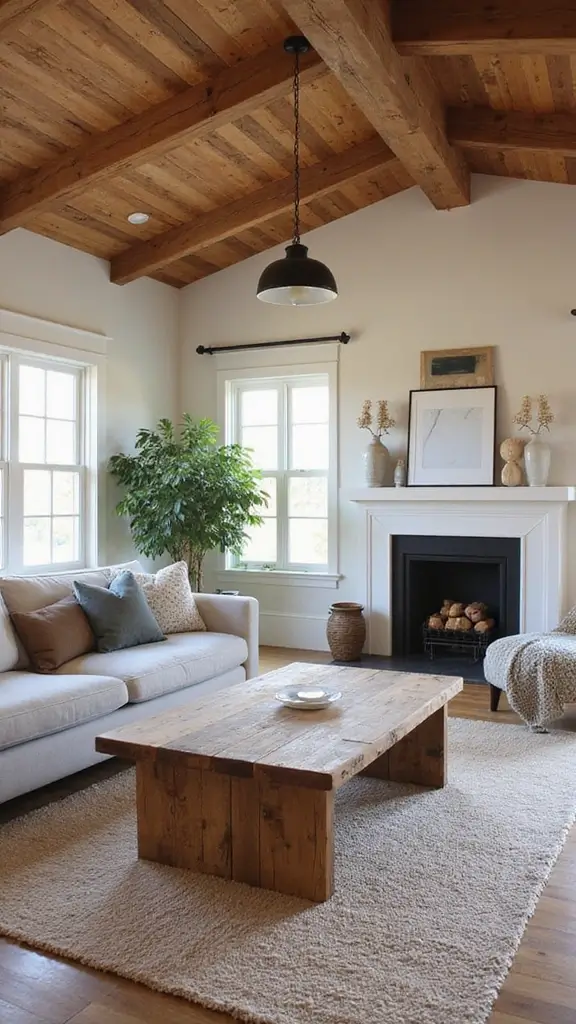
Rustic accents are essential in achieving the perfect colonial charm. Wooden beams, reclaimed barn doors, and stone fireplaces not only add character but also a sense of authenticity to your home. Pairing these elements with sleek, modern lines creates a stunning juxtaposition that feels both classic and contemporary.
Consider incorporating a reclaimed wood coffee table like the Martin Svensson Home Monterey Solid Wood Coffee Table. This piece not only tells a story of sustainability and craftsmanship but also offers functionality, enhancing the warm and lived-in feel of your space. A farmhouse-style dining table, such as the farmhouse-style dining table set by Tribesigns, can serve as a gathering spot for family and friends, further enriching your home’s inviting atmosphere.
To keep the rustic elements from feeling overwhelming, balance them with modern touches. Installing a modern lighting fixture like the LED ceiling light can elevate your rooms, creating contrast while providing essential illumination. This blend of rustic and modern prevents your home from feeling stuck in the past while ensuring it is grounded in tradition. Moreover, sourcing rustic elements from sustainable local artisans supports ethical living practices, enhancing your home’s story.
4. Brighten Spaces with Modern Lighting
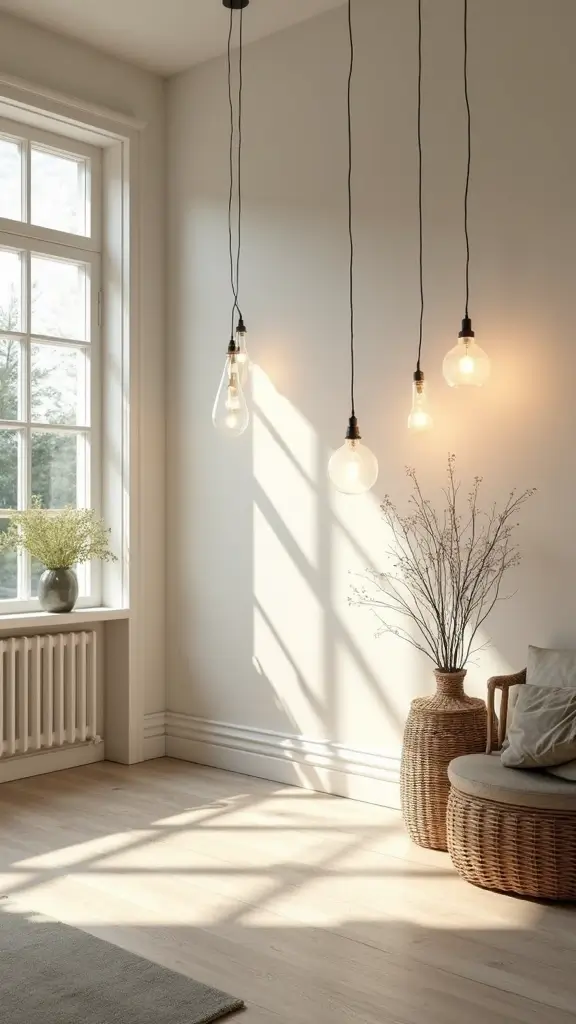
Lighting can radically transform the ambiance of a colonial home. While traditional chandeliers and sconces have their appeal, integrating modern lighting fixtures adds an unexpected twist. For instance, the modern pendant light features a sleek design with a clear glass cylinder that can beautifully complement the historic architecture while providing essential illumination, particularly over kitchen islands or dining tables.
To maintain a balance, consider options that utilize warmth in their glow and materials that echo colonial craftsmanship, like wrought iron or wood. A great addition to your living space could be the minimalist floor lamp, which offers a tall profile with a beige lampshade, creating a cozy atmosphere without overwhelming the classic elements of your home. This lamp is not only stylish but also functional, making it perfect for reading nooks or corners that need a touch of light.
With multiple layers of lighting, including task, ambient, and accent, you can create a dynamic atmosphere that reflects your personality. Sustainable lighting options, such as the LED light bulbs, can reduce energy consumption without sacrificing style. These bulbs offer a bright 5000K daylight appearance, making them ideal for lively spaces while ensuring longevity with up to 15,000 hours of use.
Moreover, utilizing natural light through strategic window placement and treatment allows your spaces to breathe and feel open. Hence, blending lighting styles can illuminate the beauty in both modern and traditional design, making your colonial home feel fresh and inviting.
5. Refresh the Kitchen with Modern Appliances
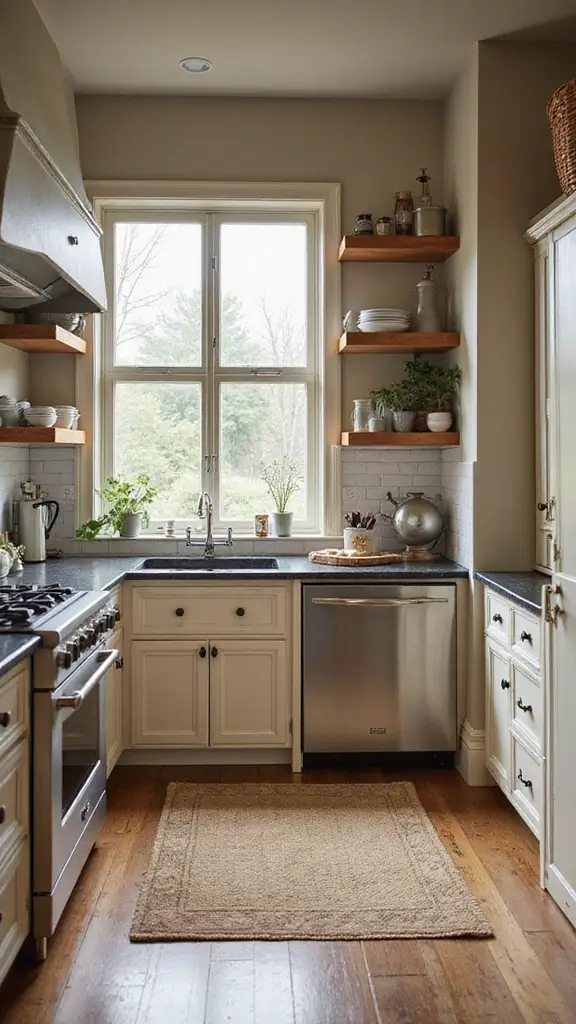
The kitchen is often the heart of the home, making it essential to blend old and new seamlessly. In a colonial setting, consider keeping classic cabinet designs, perhaps in a beautiful painted finish, while integrating energy-efficient modern appliances. For instance, the Energy-Efficient Stainless Steel Refrigerator offers a sleek look that complements traditional aesthetics without overwhelming them.
Incorporating a vintage-inspired range can enhance the overall decor while providing functionality. The Vintage-Inspired Gas Range features a compact design with sealed burners, making it perfect for blending style with modern efficiency. This oven not only adds character to your kitchen but also ensures you can cook with ease.
Adding a rustic wooden island can serve as a beautiful centerpiece, providing extra seating and workspace. The Rustic Wooden Kitchen Island enhances the warm, inviting feel of your kitchen and works nicely with modern bar stools for a fresh touch that invites conversation. Lastly, use open shelving to display your favorite vintage dishware alongside contemporary ceramics, creating a curated feel that merges eras. This kitchen will be a place of gathering, conversation, and creativity.
Blend tradition with innovation: Keep classic charm while embracing modern efficiency in your colonial kitchen. A vintage touch paired with energy-efficient appliances can create both beauty and functionality!
6. Create a Cozy Reading Nook with Sustainable Materials

A reading nook is a delightful addition to any colonial home, providing a space for relaxation and reflection. Incorporating sustainable materials, like a reclaimed wood bookshelf, enhances the charm while being eco-conscious. This bookshelf not only adds character but also serves as a perfect place to display your favorite books, combining vintage finds with contemporary reads.
Choose a dedicated corner by a window or in a quiet room, and fill it with comfortable seating. Consider adding organic cotton cushions for a touch of comfort. These cushions are not only environmentally friendly but also provide a soft spot to sink into as you dive into a good book.
To create warmth and a sense of comfort, layer a vintage throw blanket over a modern chair. This addition not only enhances the cozy aesthetic but also invites you to snuggle up with your favorite stories. Hanging a few plants nearby can introduce fresh air and a pop of color, making the nook feel alive. This space should feel like a retreat, a place to escape into stories while surrounded by a blend of old-world charm and modern comforts.
7. Utilize Bold Artwork as a Focal Point
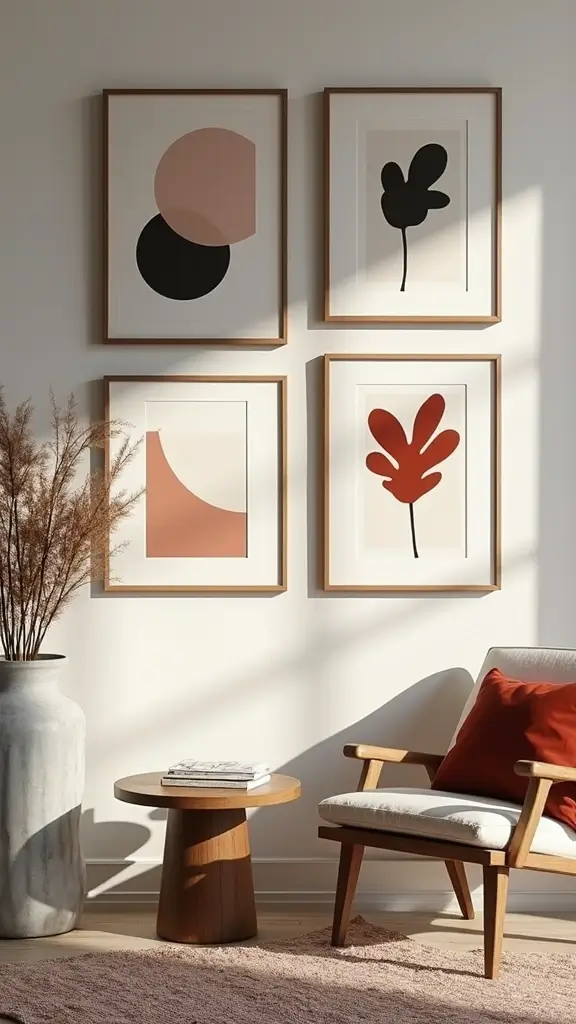
Art can be a powerful tool in interior design, and bold artwork often serves as a fantastic focal point in a colonial space.
Mixing modern art with traditional frames can create an intriguing visual dialogue. For instance, a vibrant abstract painting, like the abstract canvas painting, can stand out beautifully against classic wallpaper or dark wood paneling, adding a contemporary twist to your decor.
When selecting artwork, think about pieces that resonate with your personal style, whether they evoke nostalgia or challenge traditional aesthetics. Incorporating something like the gallery wall art set can help you create a stunning display that combines both vintage and modern art, adding depth and character to any room. It’s perfect for showcasing a mix of styles that reflect your journey and taste.
Moreover, consider supporting local artists for a sustainable touch that adds uniqueness to your collection. The classic picture frames can be a great way to elevate smaller pieces or cherished photos, enhancing the overall aesthetic of your space.
The key is to let the artwork shine without overcrowding the area; allow for ample negative space around each piece to draw attention and create balance. This thoughtful curation can ignite conversation and reflection, making your home truly a work of art.
8. Blend Textures for Maximum Impact
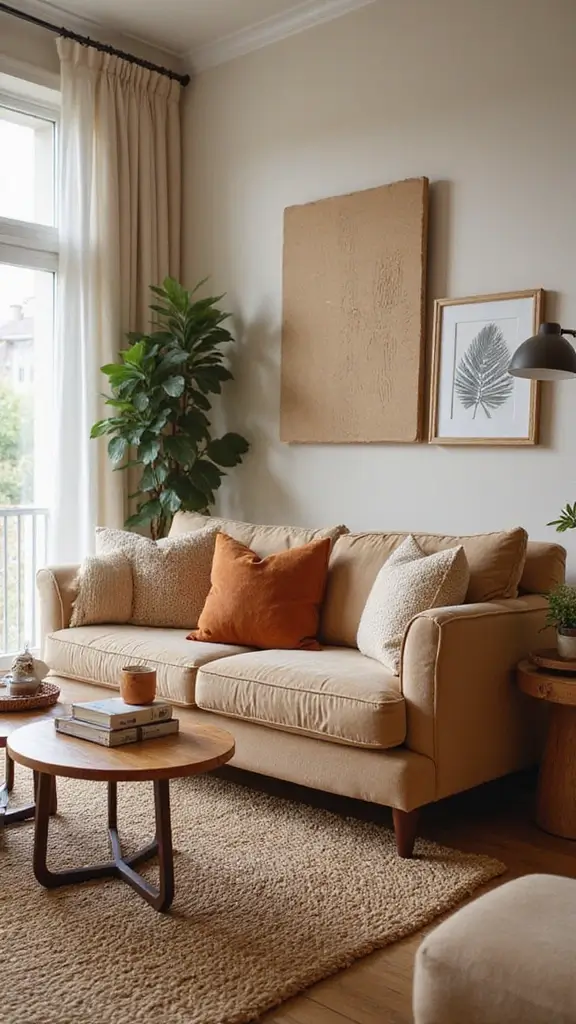
Mixing textures adds depth and interest to a colonial interior design. A combination of soft fabrics, rough woods, and smooth metals can create a layered look that feels inviting and dynamic. For example, pairing a plush velvet sofa with a reclaimed wood coffee table not only adds character but also grounds your space with a rustic touch. To enhance the feeling of warmth, consider adding a jute area rug that provides a natural, organic feel underfoot.
The interplay of these textures can draw the eye and create a tactile experience throughout the space. Incorporating natural materials like stone, woven baskets, and organic textiles supports sustainable living while enhancing the rustic charm of a colonial home. Think about using a mix of throw pillows, such as plush velvet throw pillows in light yellow, which can add a bright pop of color and comfort to your sofa. Perhaps some pillows are knitted, while others are in crisp linens, showcasing your personal style while enhancing the overall comfort of your seating area.
Remember, balance is key; too many textures can overwhelm, so select a few that harmonize to tell a cohesive story about your space.
9. Open Up Spaces with Mirrors
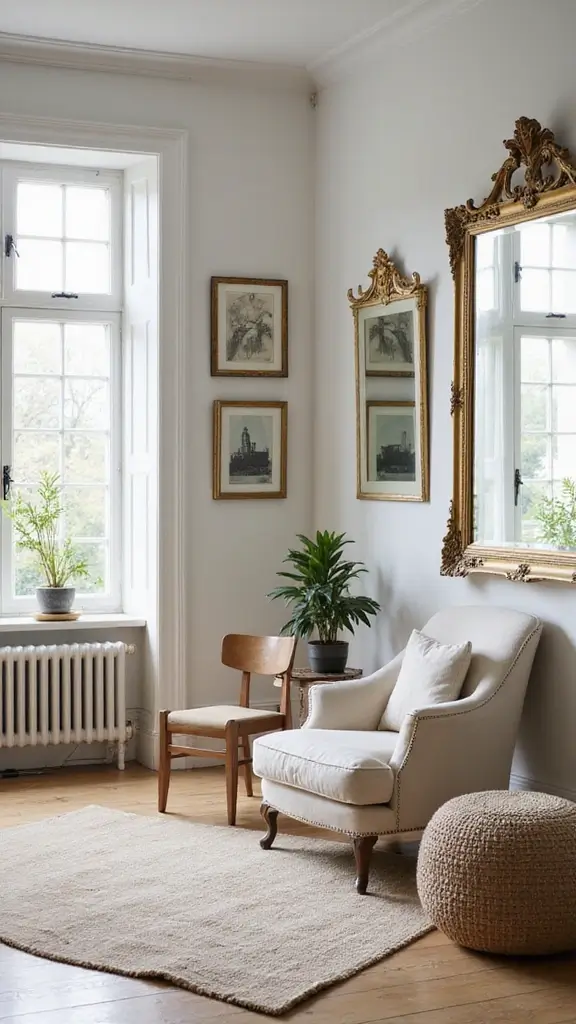
Mirrors can transform a space, making it feel larger and brighter. In a colonial home, consider using vintage or antique mirrors with ornate frames, like the vintage ornate frame mirror, to maintain the historical aesthetic. Placing mirrors strategically to reflect natural light can enhance the overall feel of openness and spaciousness.
For instance, a large vintage mirror over a mantel can serve as a stunning focal point while visually expanding the room. Additionally, you might create a gallery wall of smaller mirrors, mixing styles and shapes to keep it visually interesting. The gallery wall mirror set is perfect for this purpose, as it offers an assortment of asymmetrical wood mirrors that can be hung both vertically and horizontally.
If you’re looking for a more sustainable option, the sustainable material wall mirror is a great choice. These unbreakable tiles can be arranged in various configurations to reflect light while remaining eco-friendly. Using mirrors doesn’t just amplify light; they can also reflect the beauty of your decor, making every element shine. This means your blend of modern and traditional design will be beautifully encapsulated in the reflections throughout your home.
10. Opt for Sustainable Flooring Options
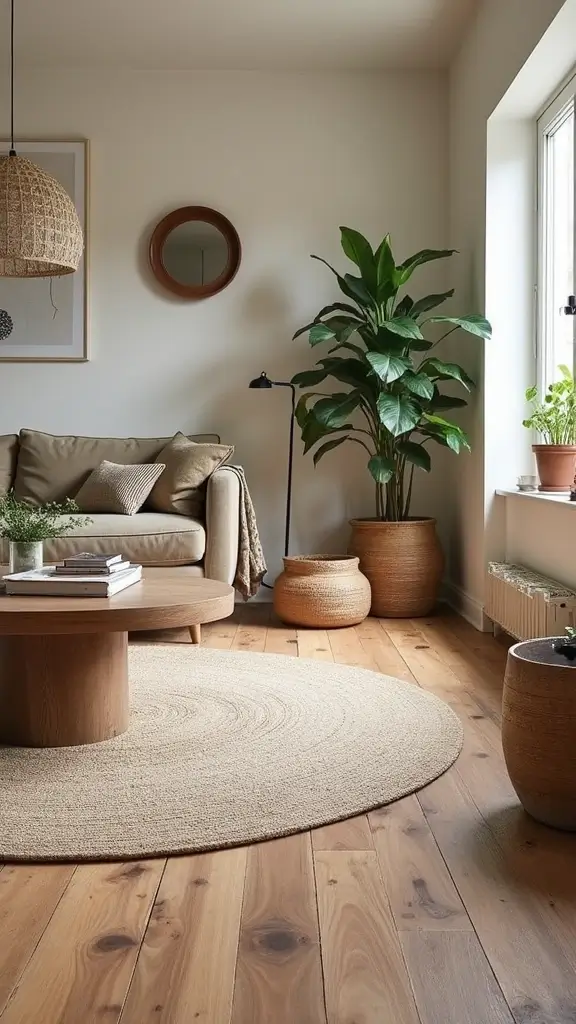
Flooring is a significant aspect of any home design, and choosing sustainable options can make a notable difference. Consider installing reclaimed wood flooring, which evokes rustic charm while being environmentally friendly. Made from reclaimed wood, this flooring not only adds natural warmth to your home but is also durable and easy to maintain.
If you prefer a more contemporary look, bamboo flooring is an excellent option. This peel-and-stick vinyl plank flooring is waterproof, making it suitable for various areas in your home, and its sustainable nature adds to the eco-friendliness of your decor.
To enhance the comfort and visual appeal of your space, area rugs can play a crucial role. Look for rugs made from organic fibers, such as the organic fiber area rug, which is handmade from jute. This rug adds color and texture while keeping your feet warm, contributing to a sustainable decor.
Mixing different flooring styles within open spaces—like hardwood in the living area and tile in the kitchen—creates visual interest and can help delineate spaces without erecting walls. Be sure to use finishes that are low in VOCs to enhance air quality and maintain an eco-friendly home. This thoughtful approach to flooring reflects a commitment to both style and sustainability.
11. Curtains: Where Tradition Meets Modernity

Window treatments can easily bridge the gap between traditional colonial design and modern aesthetics. Consider using sheer lightweight curtains like the NICETOWN White Sheer Curtains, which are airy and elegant, paired with heavier drapery for a layered look that adds depth and softness to your windows. This combination not only enhances your space but also allows light to filter through, creating a warm and inviting atmosphere.
For a more classic touch, selecting fabrics made from organic cotton, such as the organic cotton drapery in ivory, can lend an eco-friendly yet timeless feel to your home. The natural texture of cotton complements the colonial charm beautifully while also promoting sustainability.
If you’re looking to infuse some personality into your space, bold patterns can do just that. The bold patterned curtain panels by Topfinel, featuring a vintage floral design, can enhance the colonial aesthetic while adding a contemporary flair. These curtains can be used alongside your sheer options to create a stunning layered effect.
To elevate the overall look, consider hanging your curtains higher than the window frame. This simple trick creates the illusion of taller ceilings, making your rooms feel more expansive. Mixing different patterns within your window treatments can also add visual interest, as long as you keep the color palette cohesive. By choosing sustainable materials, you not only beautify your space but also contribute to a healthier planet. Window treatments can truly be the finishing touch that ties together your colonial home design beautifully.
12. Stylish Storage Solutions
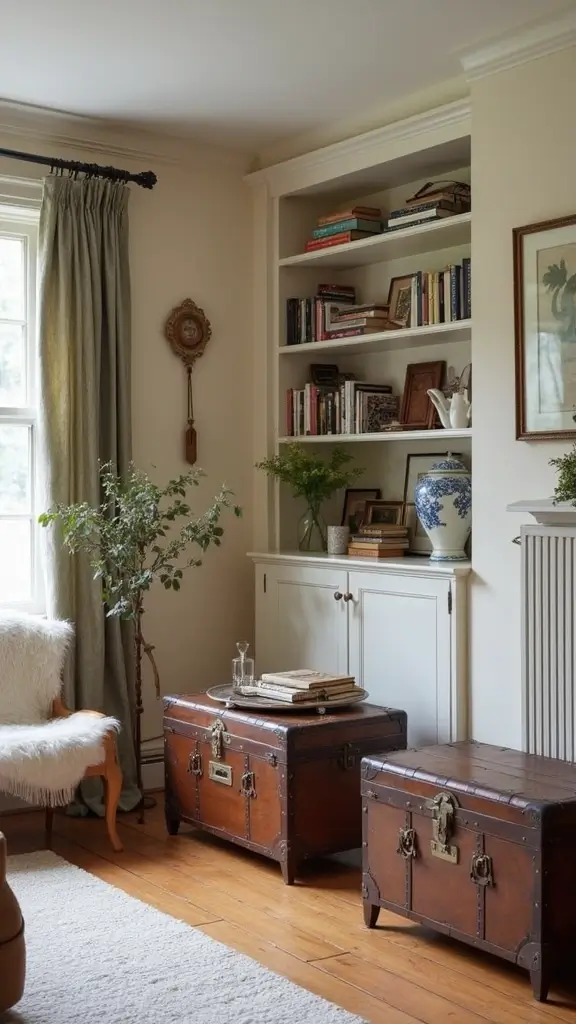
Storage can often become a challenge in colonial homes, but stylish solutions exist that blend form and function. Adding vintage trunks or wooden crates can provide both storage and stylish accent pieces within your decor. For instance, a vintage trunk at the foot of the bed not only serves as storage but also adds a unique design element with its blue body, brown lid, and floral design.
Consider built-in shelving that matches original woodwork to maintain a streamlined look, creating a seamless transition from old to new. Incorporating open shelves can display beautiful vintage dishes or modern decor items, merging styles while promoting sustainability by reducing clutter. Additionally, you might look for multi-functional furniture, like the multi-functional ottoman, which doubles as storage and provides a comfortable footrest, keeping your space organized and stylish.
If you’re looking for smaller storage options, the wooden crates nested set offers a charming way to organize while enhancing your aesthetic. These small changes can enhance functionality while preserving the aesthetic character of your home.
13. Design a Welcoming Entryway

The entryway sets the tone for your home, so it’s crucial to get it right. In a colonial design, consider using traditional elements like a wooden bench to create a warm welcome. The Sawmill Long Wood Bench offers a rustic charm that aligns perfectly with colonial aesthetics while providing a comfortable spot for guests to sit. Pair this with modern accents such as a minimalist mirror to add a fresh and sleek touch to your entryway. The Sweetcrispy Arched Full Length Mirror not only serves a functional purpose but also enhances the sense of space and light.
Incorporate sustainable materials by choosing items like the reclaimed wood bench to align with eco-friendly principles. Adding some greenery through indoor potted plants will liven up the space and embody sustainable living. These easy-to-grow air-purifying plants not only add freshness to your entryway but also contribute to a healthier indoor environment.
To further enhance comfort, consider using a bold rug that creates a sense of warmth underfoot, making guests feel right at home. Additionally, don’t forget to include a space for coats and shoes, perhaps through stylish hooks or baskets, to keep everything organized while maintaining the aesthetic. Your entryway can be a thoughtful design statement that reflects your personal style from the very first step inside.
14. Accent Walls with Historical Patterns
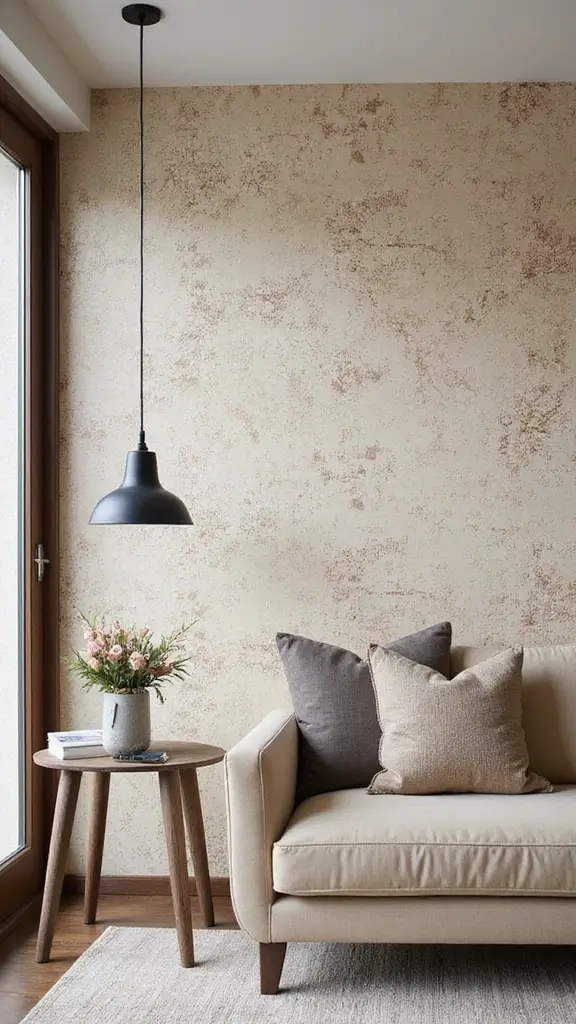
Accent walls can add stunning focal points within your colonial home. Opt for wallpaper or paint that features historical patterns, like damask or floral designs. These classic motifs can transport you back in time while still feeling fresh when paired with modern furniture. For an eco-friendly touch, consider using sustainable wallpaper, which is made from environmentally friendly materials and is renter-friendly, making it easy to apply and remove.
Another option is to use reclaimed wood planks to create a textured accent wall that adds warmth to the space. This can be particularly stunning in a dining area, providing an intimate backdrop for family gatherings. Experiment with colors that complement your existing palette, ensuring the overall harmony of the room. Remember, an accent wall is not just about color; it’s about creating a narrative that feels cohesive with the overall design. A thoughtfully chosen accent can enhance the historic narrative of your home.
15. Curate a Personal Gallery of Family Heirlooms

Incorporating family heirlooms into your design is a beautiful way to blend personal history with your interior. These pieces can serve as conversation starters while adding a unique charm that cannot be replicated. Displaying items like old photographs, vintage dishes, or handmade crafts in a gallery-style layout can personalize your space.
To create a stunning gallery wall, consider using matching frames for uniformity, like this gallery wall frame set. This set includes classic black frames that perfectly highlight your cherished memories. Mixing and matching frames can also achieve a more eclectic look.
In addition to frames, modern shelving can enhance your display while keeping with a clean and contemporary aesthetic. The floating shelves are perfect for showcasing your heirlooms, providing a rustic touch that honors tradition. These shelves are ideal for any room, be it the living room or hallway, ensuring your family’s legacy is celebrated in a prominent location.
Don’t forget to include decorative elements like the vintage decorative boxes. These charming boxes can not only serve as storage for small items but also add a retro flair to your décor. This thoughtful curation creates a home filled with warmth and character, beautifully reflecting your journey through time.
16. Add a Touch of Nature with Indoor Plants
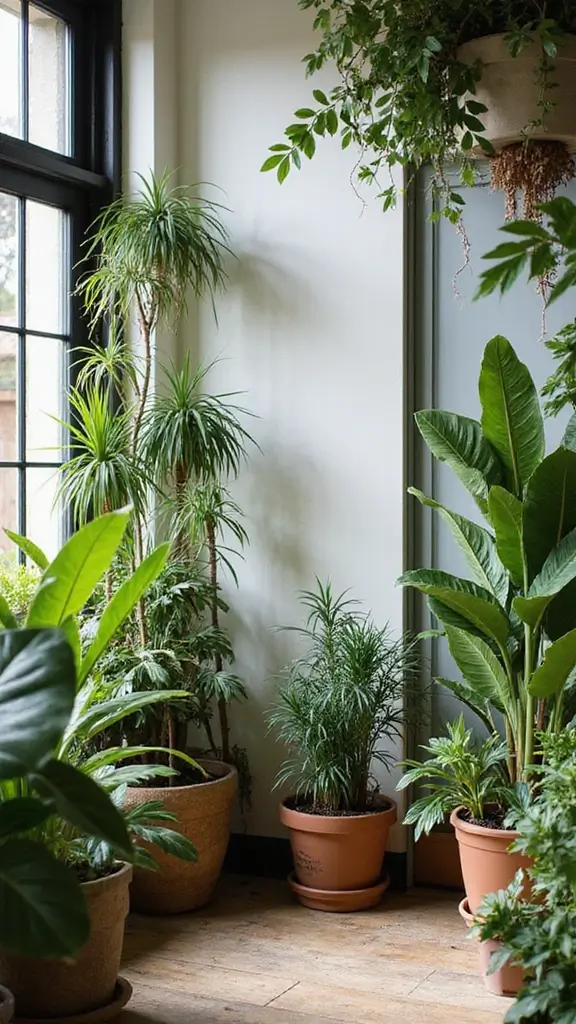
Indoor plants are perfect for bringing life into any space, especially in a colonial home where nature complements tradition beautifully. Opt for large leafy plants like the Fiddle Leaf Fig Plant or
Rubber Plant that can easily fill corners and draw the eye. Adding smaller plants on shelves and tables creates a layered look that adds vibrancy.
When choosing pots, consider terracotta plant pots made from organic materials, which not only enhance the aesthetic appeal but also provide a sustainable touch. The earthy tones of terracotta beautifully contrast with the lush greens of your plants, enriching the overall visual experience.
The hues of green from the plants contrast beautifully against traditional colonial colors, enhancing the overall aesthetic. Incorporating plants also improves air quality, making your home healthier. Think about creating a mini indoor garden by grouping plants together in varying heights and textures, adding a natural element that softens the space and works harmoniously with the decor. This simple addition can create a refreshing ambiance, making your home feel more inviting.
17. Transform with Eco-Friendly Paint
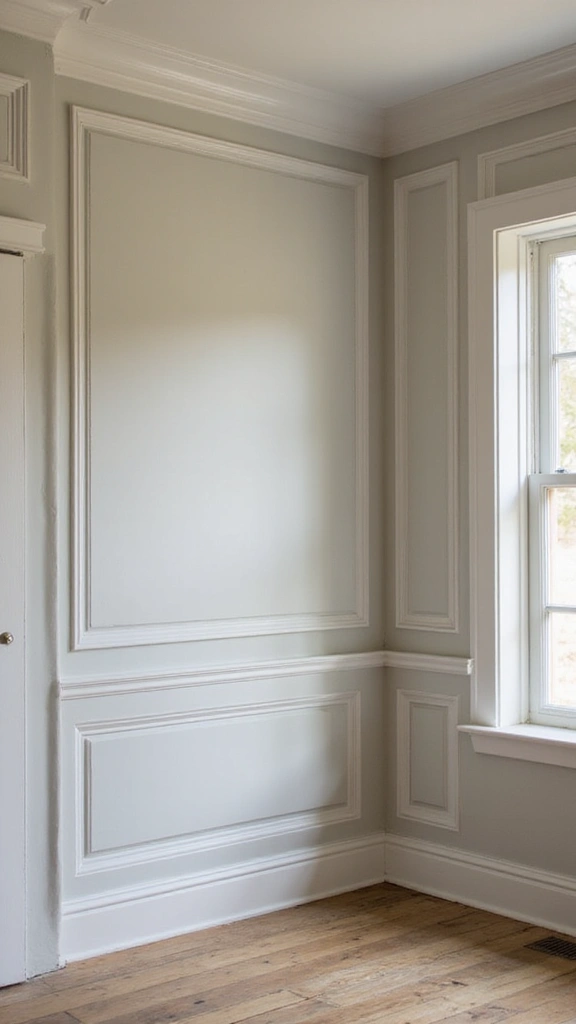
Painting is one of the easiest ways to refresh a space, and using eco-friendly, low-VOC options can enhance both aesthetics and sustainability. Choosing natural, organic paints reduces your environmental impact while offering a wide range of colors to match your decor style. For a colonial home, consider soft pastels, muted tones, or even rich jewel tones that reflect historical palettes. When painting, think about incorporating accent colors on features like door frames or moldings to highlight architectural details.
To enhance indoor air quality, consider using a non-toxic sealant like Silicone RTV 4500 Food Contact Safe High Strength Silicone Sealant. This product is perfect for ensuring that your painted surfaces are well-protected and free from harmful chemicals, which is essential for a healthy home environment.
Sustainable practices can be applied throughout your painting project, including using this sealant to complement your eco-friendly paints. Remember, the finish matters—matte or eggshell finishes can lend a more traditional feel, while glossy finishes can modernize your look. Plus, a newly painted room can breathe life into your home, making it feel refreshed and inviting.
18. Layer Carpets for Comfort

Layering carpets or rugs can add warmth and texture to any space, making it particularly inviting in a colonial home.
Start with a larger, neutral area rug to create a base, and layer a smaller, patterned rug on top for visual interest. For instance, consider the HEBE washable area rug—this 2’x3′ non-slip soft distressed medallion rug makes an excellent choice for layering. Its vintage design not only defines spaces but also adds depth and comfort to your floors.
When selecting rugs, opt for sustainable materials like wool or jute, which not only feel luxurious but also support eco-friendly practices. The layered look can complement both modern and traditional furniture, allowing you to strike a balance between styles effortlessly. Ensure that the colors and patterns harmonize with your overall decor scheme. This clever technique brings coziness to your home, creating spaces that are both functional and beautifully curated.
19. Create Custom Built-in Shelves
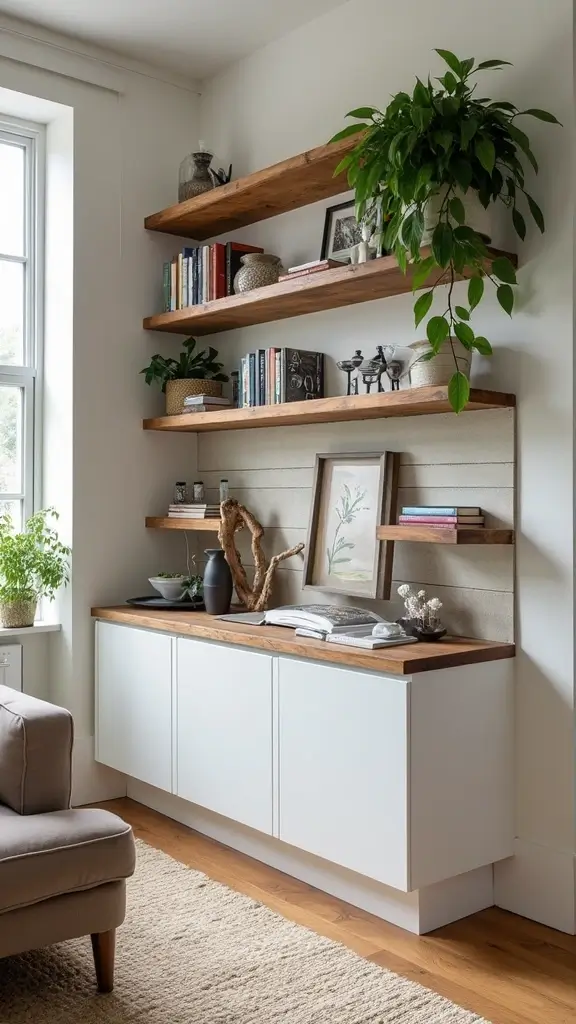
Built-in shelves can elevate your colonial home’s design while providing functional storage. These can be custom-made to fit your space, giving a seamless look that integrates with the existing architecture. Utilizing reclaimed wood for these shelves adds a rustic charm while keeping sustainability in mind. You can achieve this by using a reclaimed wood shelving kit, which is an excellent option for creating that warm, inviting atmosphere.
Consider placing books, decorative items, and plants on these shelves to create a personalized display that enhances the room’s character. To ensure your shelves are both stylish and secure, pair them with decorative shelf brackets. These heavy-duty antique brass wall brackets not only add a vintage touch but also support your shelving while blending seamlessly with the colonial aesthetic.
Mixing traditional molding styles with modern shelving designs can create a unique hybrid look that feels cohesive. Additionally, built-ins can help keep spaces organized while eliminating clutter, creating a more serene environment. Pay attention to the arrangement; a well-curated shelf can tell a story while showing off your personal style beautifully.
20. Bring in the Outdoors with Natural Light
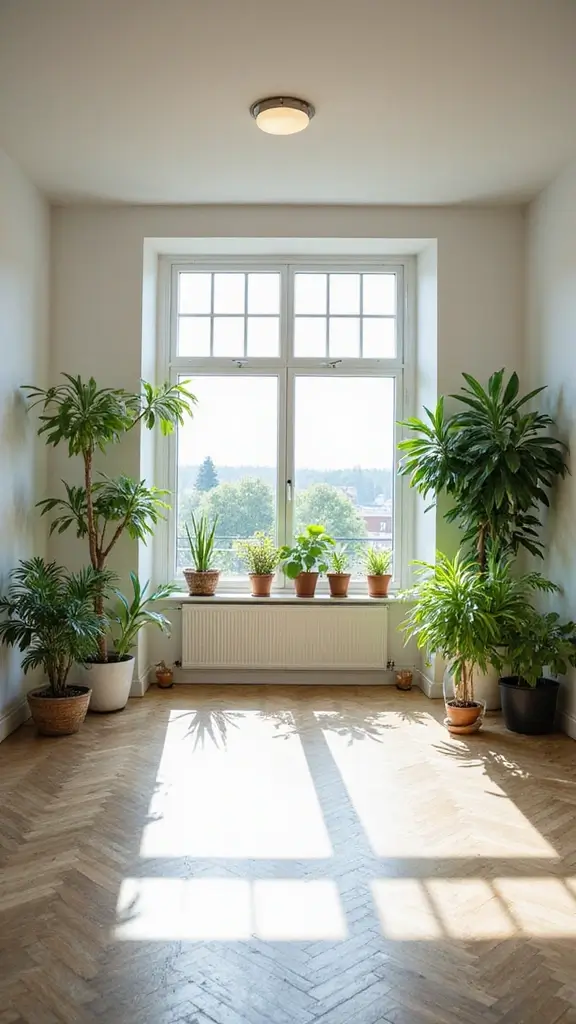
Natural light can dramatically alter the feel of your home, and maximizing its flow is essential in colonial design. Consider larger windows or glass doors that open to outdoor spaces, creating a seamless transition between indoors and out. If renovations are possible, think about adding skylights for an even greater influx of natural light.
When designing window treatments, opting for sheer fabrics is a great choice. For example, sheer window curtains can diffuse light beautifully, allowing brightness to filter through while still providing some privacy. These curtains, like the OWENIE White Sheer Curtains, add an airy feel to your space without obstructing the natural light you want to maximize.
Indoor plants can also soften the space and enhance your connection to nature. Consider easy-to-grow options, like the indoor potted plants from Costa Farms, which not only purify the air but also bring a vibrant touch to your decor. Adding greenery reinforces that outdoorsy vibe, making your home feel more inviting and lively.
Choosing light, airy colors for your walls can further reflect this brightness, making your home feel more open and welcoming. Creating a light-filled environment not only elevates your mood but also cultivates a happy, vibrant space for living.
21. Personal Touch with Custom Artwork

Custom artwork can be a beautiful way to express your personality and enhance your colonial home.
This could be a commissioned piece that reflects your style or even family portraits that capture memories. By placing these personal touches throughout your home, you create a unique narrative that resonates with both modern and traditional aesthetics. Consider framing these artworks in vintage frames or contemporary styles, varying the looks for a dynamic feel. If you’re artistically inclined, creating your own pieces can add even more significance to your decor. The presence of personal artwork invites conversation, adding depth and character to each room. Additionally, supporting local artists or sustainable art initiatives reinforces your commitment to eco-friendly practices, making your home a true reflection of your values and style.
22. Use Multi-Functional Spaces

In a colonial home, maximizing space use is key to creating a functional yet stylish living environment. Designating areas for multiple purposes—like a dining room that doubles as a workspace—can enhance usability without compromising decor. For instance, incorporating furniture that offers storage, such as a dining table with drawers, can help keep the area organized.
A great option for adding versatility to your living space is the Flamaker futon sofa bed. This modern folding futon set not only provides a comfortable seating area but also easily converts into a bed for guests, making it perfect for multi-functional designs. It features two cup holders and removable armrests, adding both convenience and comfort to your setup.
Additionally, consider using collapsible or extendable furniture for flexibility when entertaining or hosting family gatherings. By incorporating smart design solutions like the futon sofa bed, you can create an inviting atmosphere that serves various functions while still feeling cohesive and stylish. This adaptable approach can significantly enhance the livability of your home, making every corner count.
23. Balance Old and New with Transitional Furniture
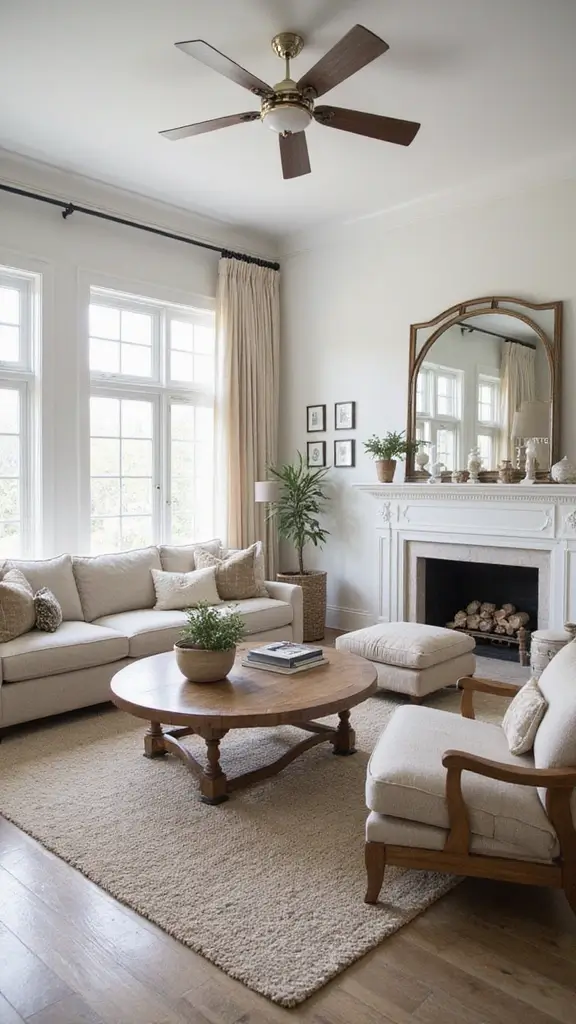
Transitional furniture design offers a perfect solution for those looking to blend modern styles with traditional elements in their colonial home. Pieces that incorporate classic styles with a contemporary twist can create harmony throughout the space. For example, selecting a coffee table with a vintage shape but a sleek finish or a classic wingback chair reimagined in modern fabric enhances the overall aesthetic.
Consider adding a solid wood dining bench with backrest – modern traditional furniture to your entryway or living room. This piece not only brings a stylish touch but also showcases sustainable design, making it a thoughtful choice for your home. It harmonizes well with existing decor while providing plenty of functional seating.
This thoughtful selection of furniture can offer a cohesive look that bridges the gap between eras. Balance is key; mixing too many styles can overwhelm, so opt for a few select transitional pieces that stand out while complementing your existing decor. This approach allows you to express your unique style while honoring the architectural heritage of your home.
24. Celebrate Tile’s Timeless Appeal
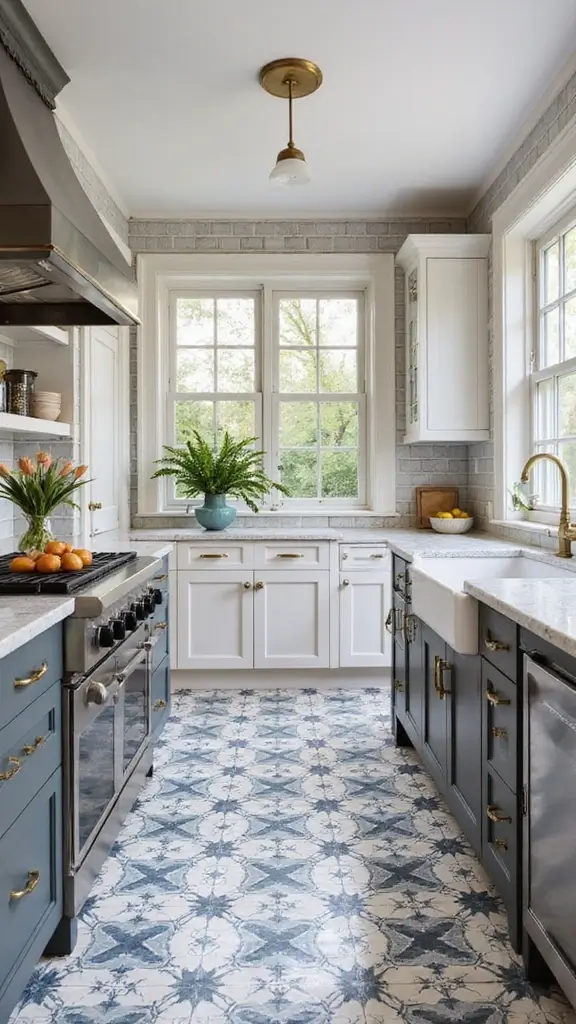
Tiles can offer a timeless charm in colonial homes, whether in kitchens, bathrooms, or as decorative accents throughout your space. Opt for classic patterns and colors that reflect colonial design, like hexagonal tiles or subway tiles, which bring elegance while maintaining a historical touch. For instance, a great solution for your kitchen or bathroom is the 10 thick white subway tile peel and stick backsplash self-adhesive wall tiles. These tiles not only echo traditional design but are also incredibly convenient to install, providing a seamless update to your space.
Using sustainable tile options made from recycled materials enhances your aesthetics while supporting eco-friendly living. Consider incorporating a bold tile backsplash in the kitchen or a patterned mosaic in the bathroom. The blue shower floor pebbles tile bathroom mosaic backsplash wall tiles offer a unique touch, creating visual interest that adds a modern flair while honoring historical design principles.
Tiles are durable and easy to maintain, making them a practical choice for high-traffic areas. Mixing different tile shapes and layouts can create a unique design that stands out while celebrating the timeless appeal of traditional homes.
25. Revive Spaces with Bold Accents

Incorporating bold accents can reinvigorate a colonial home, providing fresh energy while maintaining historical charm.
Consider introducing striking colors through accessories, like vibrant cushions or modern art pieces, that pop against classic backdrops. For instance, a piece like the Roundhill Furniture AC155YL Doarnin silky velvet tufted button accent chair in bright yellow can serve as a statement piece that draws attention and creates a focal point within the decor. Additionally, a rich blue side table, such as the Powell Phipps navy blue round side table, adds a splash of color while providing functional space for decor or lighting.
Pairing these bold elements with neutral foundations helps maintain balance and prevents the space from feeling chaotic. Don’t hesitate to mix patterns and textures within these accents to create a layered look that feels dynamic yet harmonious. This playful approach to decor can add both personality and flair, making your home a true reflection of your style.
26. Emphasize Open Spaces with Minimalist Design
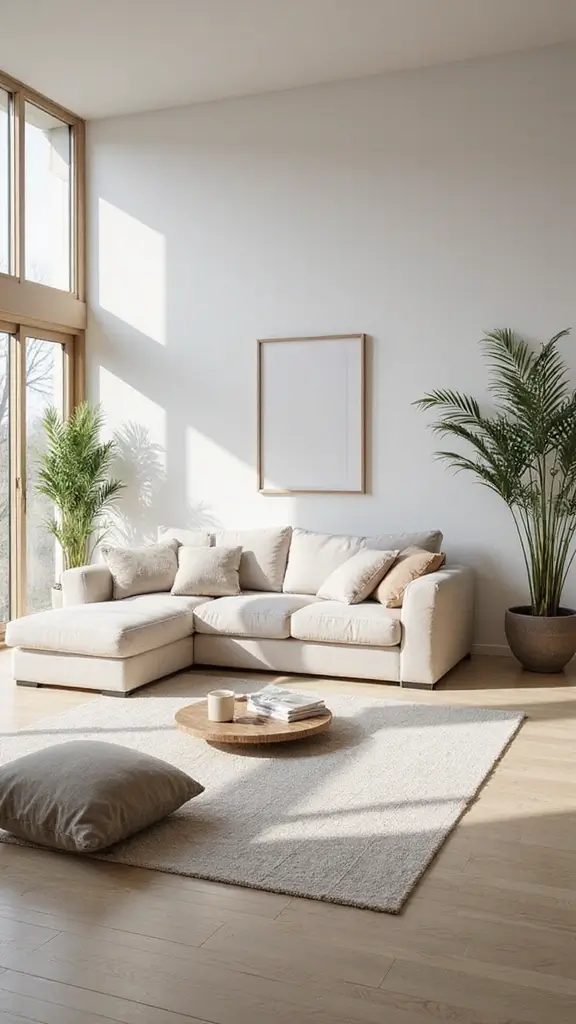
Minimalism can be an excellent approach to colonial home design, allowing the architectural details to shine while maintaining a clean, clutter-free environment.
By emphasizing open spaces and simplicity, you can create an ambiance that feels both airy and sophisticated. Choose furniture with clean lines and avoid overcrowding with excessive decor. Stick to a cohesive color palette that complements your existing woodwork and architectural features. Incorporating multi-functional pieces like a sleek dining table or a minimalist coffee table can enhance functionality without sacrificing style. Additionally, let natural light guide your design choices, keeping window treatments light and airy to promote visibility. This approach fosters a serene environment that feels spacious and inviting while respecting the historical significance of your home.
27. Honor History with Found Objects
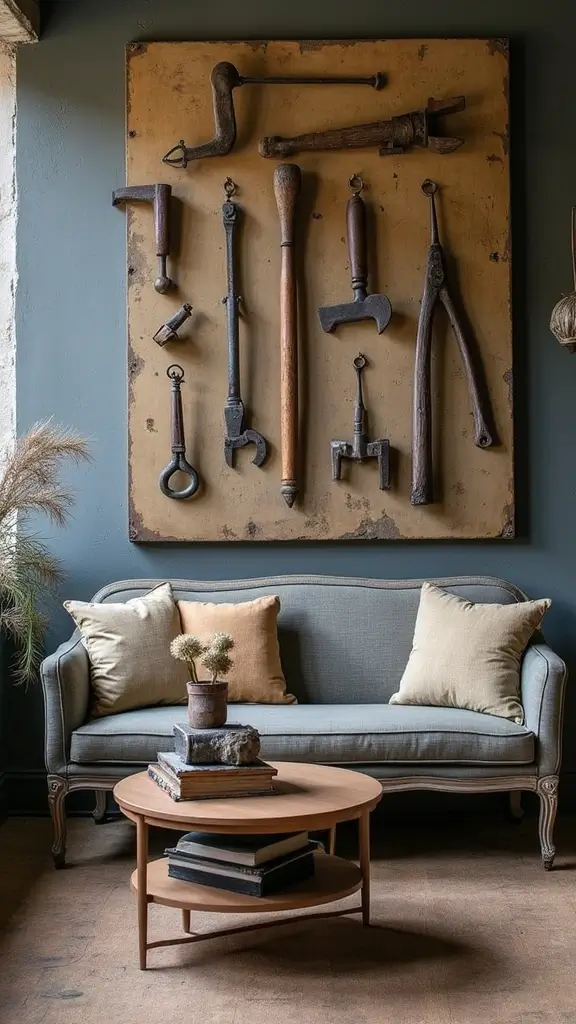
Incorporating found objects into your decor can celebrate the character inherent in colonial design.
Items like vintage tools, old books, or unique trinkets can tell stories of the past while enhancing your decor’s authenticity. Use these objects as decorative accents on shelves, mantels, or in shadow boxes to create intriguing displays. Pairing these with modern decor helps to create dialogue between old and new. Look for sustainable ways to source these items, perhaps from flea markets or local artisans, ensuring that each piece has its own narrative. By embracing the charm of found objects, you create a home that feels rich in history and character, making every corner a reflection of your journey.
28. Thoughtful Layering with Throws and Pillows
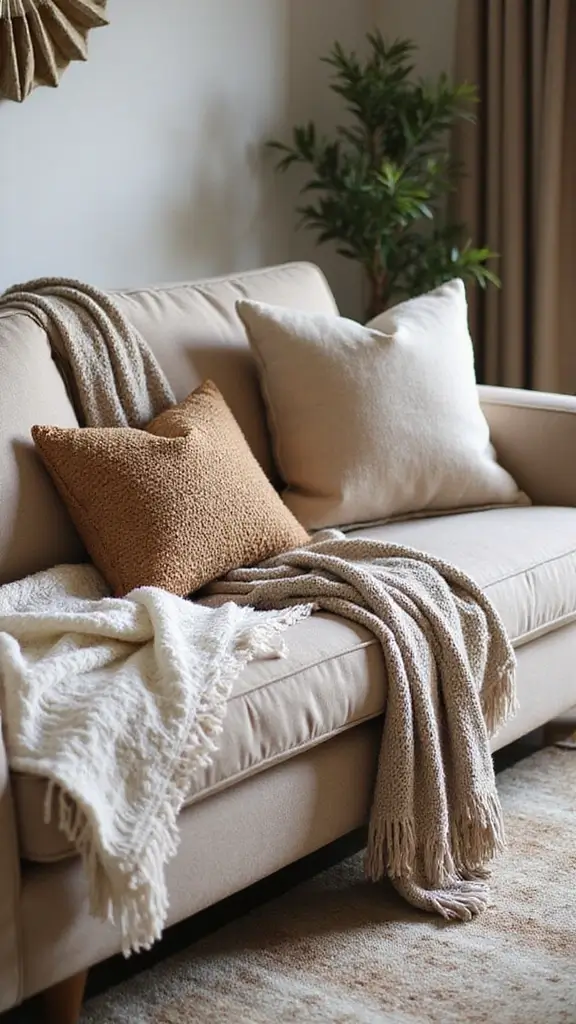
Layering throws and pillows can add warmth and comfort while also enhancing the visual appeal of your rooms.
Choose a mix of textures, colors, and patterns that complement both modern and colonial styles. For example, layer a chunky knit throw over a sleek sofa, or pair patterned pillows with solid colors for balance. Ensure your choices reflect a cohesive palette that resonates throughout your home. Mixing organic fabrics like cotton, wool, and linen can elevate the sensory experience, inviting guests to sink into comfort. Additionally, consider changing up your throw pillows seasonally to refresh your decor without significant investment. This layering technique creates a cozy and inviting atmosphere, making your home feel welcoming.
29. Elevate Spaces with Unique Light Fixtures
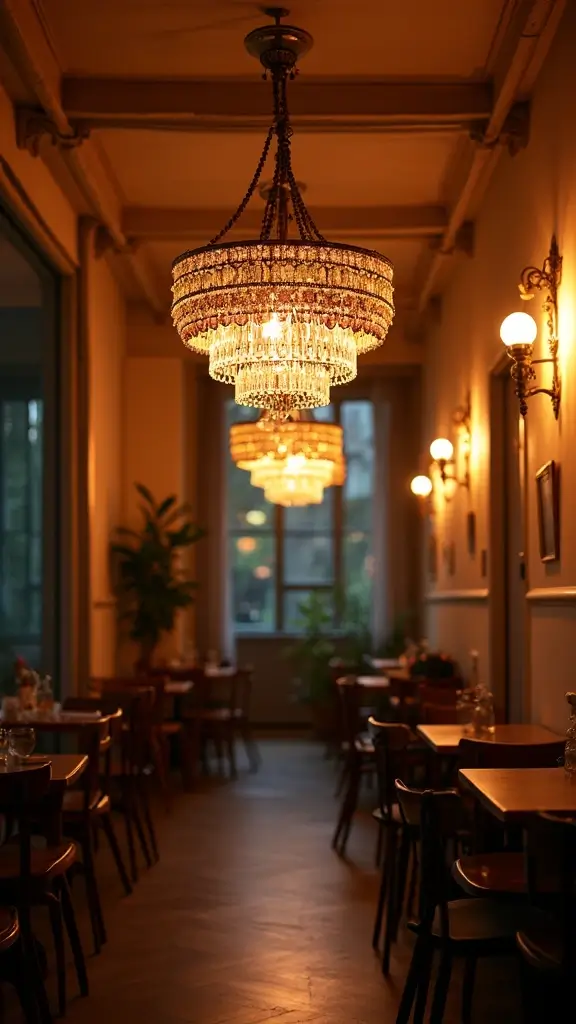
Lighting can drastically alter the mood of a room, so choosing unique fixtures that blend colonial charm with modern flair is essential.
Consider statement chandeliers or pendant lights that draw attention and become a focal point within the space. Select fixtures made from sustainable materials, like reclaimed wood or recycled metals, to align your design with eco-friendly principles. Mixing styles—like a vintage chandelier paired with modern sconces—creates an interesting dialogue throughout your home. Ensure the lighting fixtures provide adequate illumination while also enhancing the aesthetic, creating an environment that feels warm and inviting. Thoughtful light choices can transform spaces, celebrating both historical significance and modern design beautifully.
30. Celebrate Artisanal Craftsmanship
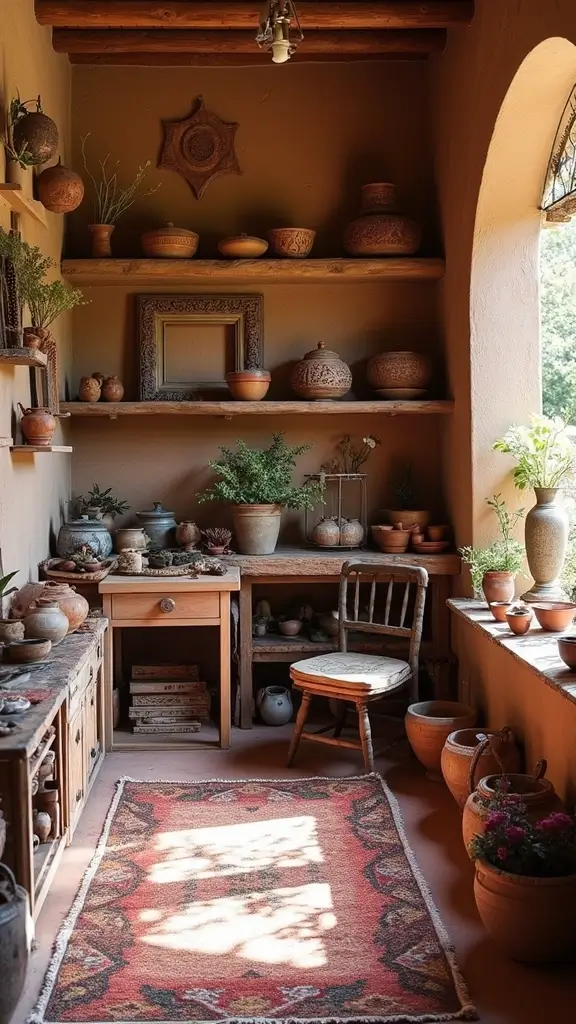
Incorporating artisanal pieces into your decor not only supports local artisans but also enhances the character of your colonial home.
Look for handmade items—such as pottery, textiles, or woodworking—that reflect a unique craftsmanship and tell a story. Mixing these artisanal pieces with modern elements creates an inviting and personalized space that celebrates both history and contemporary design. Consider using sustainable materials in these handcrafted items, ensuring that your decor choices align with eco-friendly practices. Using artisan-crafted items adds a layer of authenticity, making your home feel distinct and thoughtfully curated. Celebrating craftsmanship fosters a sense of connection to both the local community and the narratives that shape your living environment.
31. Set the Mood with Warm Lighting
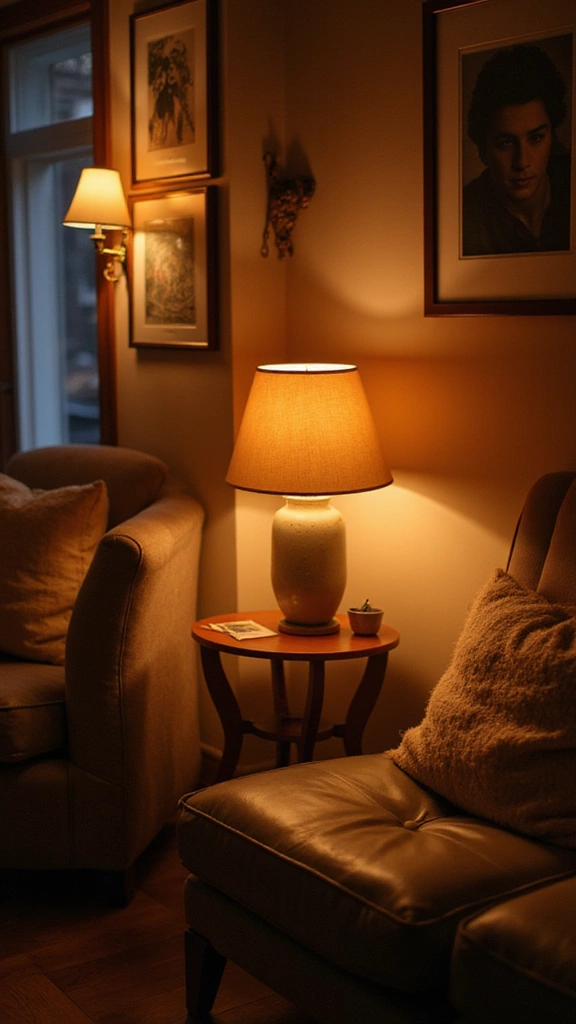
Warm lighting is essential for creating a cozy and inviting atmosphere in your colonial home. Consider pairing LED bulbs with warm tones, such as the LED warm white light bulbs, which offer a soft white light that enhances the ambiance while being energy-efficient.
Utilize table lamps like the fabric shade table lamp, designed with a linen beige lampshade and a light brown wooden base, to diffuse light softly. This not only creates a welcoming environment but also adds a charming touch to your decor. Incorporating a dimmable option, such as the dimmable floor lamp with remote and touch control, allows you to adjust the lighting to suit any occasion—transitioning from bright task lighting to a soft, intimate glow.
The right choice of light can highlight architectural features, creating a sense of warmth throughout your home. Layering different sources of light—like overhead fixtures, lamps, and candles—adds depth and drama, ensuring each room feels distinct and inviting.
32. Create Connection with Open Floor Plans

Open floor plans can enhance the flow of your colonial home while allowing for versatile living experiences.
By removing unnecessary walls, you create spaces that feel larger and more connected. This design encourages interaction and engagement within the home, making it perfect for entertaining. Maintain the essence of colonial architecture by using strategic furniture placement to define areas without creating barriers. Consider integrating a large dining table that can serve as the centerpiece, bringing family and friends together. Use area rugs to delineate different functions while keeping a cohesive design. Open spaces foster communication and connection, allowing your home to serve as a gathering place for years to come.
33. Find Harmony with Earthy Tones
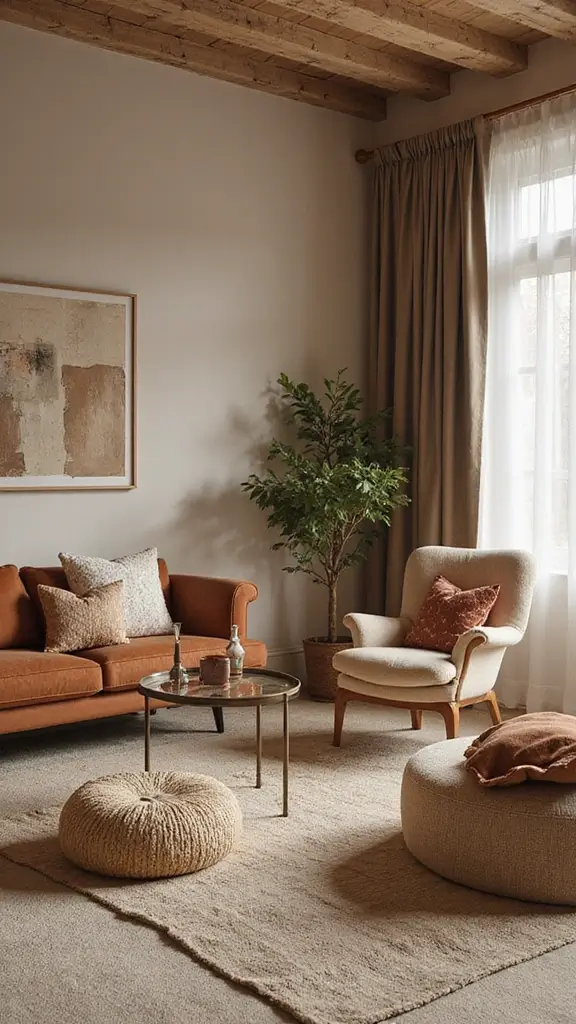
Earthy tones can create a grounding atmosphere in your colonial home, blending beautifully with both traditional and modern elements. Incorporate colors like terracotta, taupe, and moss green to evoke a sense of nature within your interiors. These colors can be utilized in paint, furniture, or decor accents, providing warmth and depth without overwhelming the space.
Pair earthy colors with natural materials—like wood and stone—to create a cohesive look that feels connected to the outdoors. Adding decorative accents, such as the Ancient Graffiti medium 5-stone natural river stone cairn, can enhance this aesthetic. The multicolored stones not only bring a touch of the outdoors inside but also add a unique focal point that complements earthy tones beautifully.
Accent with brighter pops of color in accessories for a vibrant balance. This approach promotes a calming environment, allowing for relaxation and comfort, making your colonial home a sanctuary. Embrace earthy tones in your colonial house interior design – they create harmony and warmth, connecting your space to nature while blending timeless and modern elements effortlessly!
34. Honor Tradition with Classic Patterns

Classic patterns are a hallmark of colonial design, rich with history and character. Integrating patterns like checks, plaids, and florals can evoke a sense of nostalgia while giving your decor depth. For instance, using a classic patterned area rug can anchor your living space with its vintage floral design and soft boho vibe, creating an inviting atmosphere. This washable rug not only adds texture and warmth but is also stain-resistant, making it a practical choice for high-traffic areas like the living room or dining room.
Pair patterned pieces, such as this rug, with solid colors to maintain balance, allowing each design element to shine. When incorporating patterns, consider mixing scales—large florals with smaller checks—to create visual interest while honoring tradition. Sustainable fabric choices can enhance this approach by promoting eco-friendly practices. Classic patterns, like those found in this area rug, can connect your home’s past with its present, creating a warm, lively atmosphere that feels timeless.
35. Incorporate Personalized Touches

Personalized touches can make your colonial home feel truly unique and reflective of your lifestyle. Incorporate family heirlooms or personal collections—like travel souvenirs or art pieces—into your decor to tell your story. Creating dedicated display areas for these items can celebrate their significance while adding character to your space.
Consider adding accents such as personalized throw pillows, like the Uvvyui knot pillow ball, which not only provides comfort but also adds a handmade touch to your living space. These soft, decorative pillows can blend seamlessly with both modern and traditional styles, enhancing the overall aesthetic of your home.
Moreover, think about custom furniture or decor that reflects your style preferences, ensuring everything you choose feels authentic. Personal touches can create a cohesive narrative throughout your home, encouraging a sense of belonging and warmth, making every corner feel like home.
36. Use Space Wisely with Built-In Seating
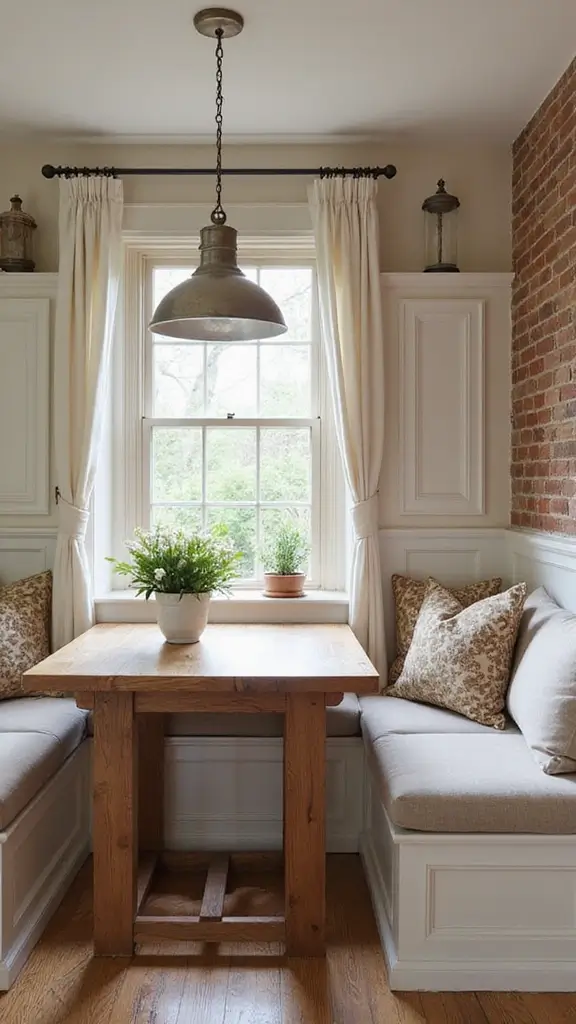
Built-in seating can maximize functionality in your colonial home while enhancing its charm. Consider creating cozy window seats with storage underneath or built-in benches in dining areas for added comfort. These options invite relaxation while providing practical solutions for space management. To ensure your seating is not only stylish but also comfortable, consider utilizing storage cushions for window seats. These gel seat cushions offer double-thick support and pressure relief, making them perfect for long family gatherings or quiet reading times.
Additionally, choosing upholstery in eco-friendly fabrics, like eco-friendly upholstery fabric, contributes to both comfort and sustainability. This fabric is perfect for concealing the frame of your built-in seating while maintaining an inviting aesthetic. Incorporating elements like reclaimed wood enhances the rustic appeal while maintaining a modern edge. Built-in seating fosters a sense of community, making it an inviting spot for family gatherings or quiet reading time. This thoughtful design emphasizes both style and practicality, ensuring your home remains functional.
Built-in seating is more than a cozy nook; it’s a smart way to blend comfort with sustainability in your colonial home. Embrace functionality while adding charm—your space will thank you!
37. Create an Outdoor Sanctuary
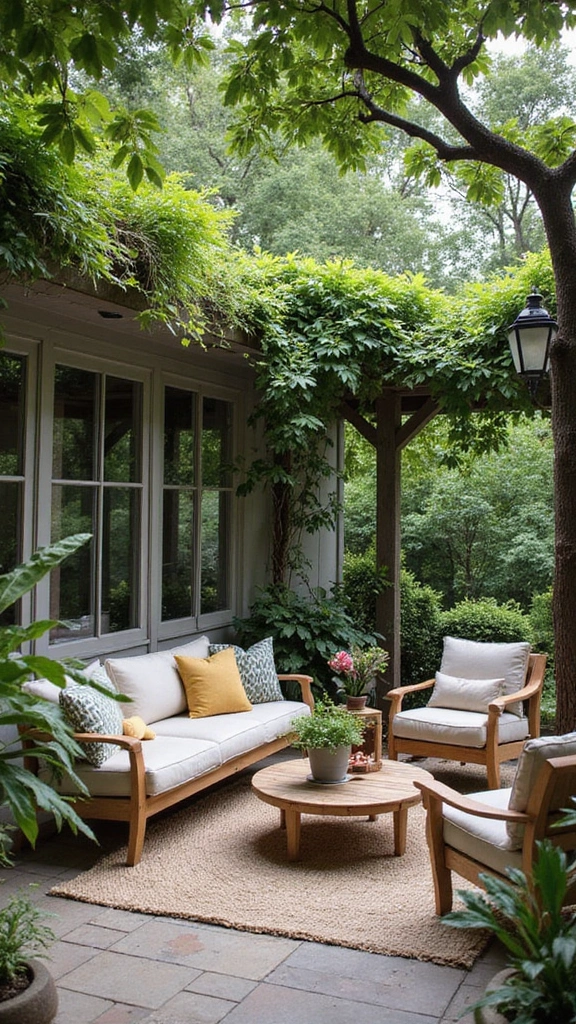
Outdoor spaces should not be overlooked in colonial home design, as they provide opportunities for relaxation and connection to nature.
Consider creating a cozy patio or garden area with furniture that complements the colonial architecture. A great option is the sustainable outdoor furniture set, which includes a wicker sofa and two rattan chairs, perfect for cozy gatherings or quiet moments. With all-weather cushions featuring a natural rattan beige color, this set allows you to enjoy the outdoors comfortably while staying true to eco-friendly practices.
Incorporating plants and natural elements can enhance the outdoor experience, creating a peaceful sanctuary. Use natural textiles for cushions and throws to maintain comfort while embracing sustainability. Lighting can set the mood, so think about adding string lights or lanterns that provide a warm glow for evenings spent outdoors. This outdoor sanctuary becomes an extension of your living space, inviting enjoyment for gatherings and tranquil moments alike.
38. Celebrate the Art of Layering
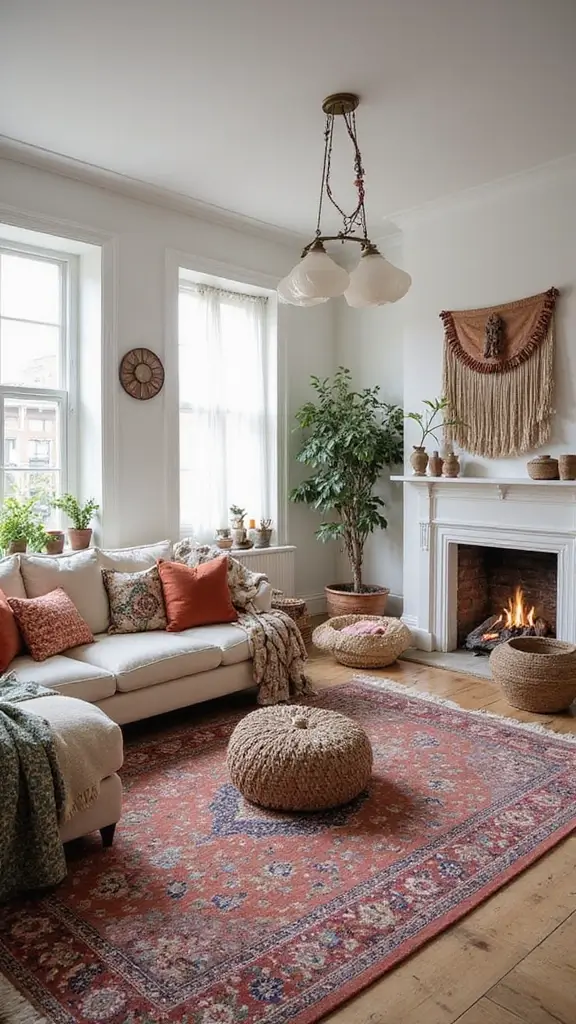
Layering is a key principle in creating depth and visual interest in your colonial home. Consider layering materials, colors, and patterns to create a rich tapestry of design throughout your spaces. For example, layer a soft area rug on a hardwood floor, combining various textures to add warmth underfoot.
One easy way to infuse personality and flair into your space is by mixing patterns in throw pillows. The Utopia Bedding throw pillows (set of 4, white) are perfect for this purpose. Their versatile design allows you to play with different patterns and colors while maintaining a cohesive color palette.
Additionally, layering decor items—such as books, plants, and art within your shelves or on tables—can create an inviting yet sophisticated atmosphere. This technique encourages comfort and warmth, making your home feel lived-in and welcoming while respecting its historical roots.
39. Modernize with Technology
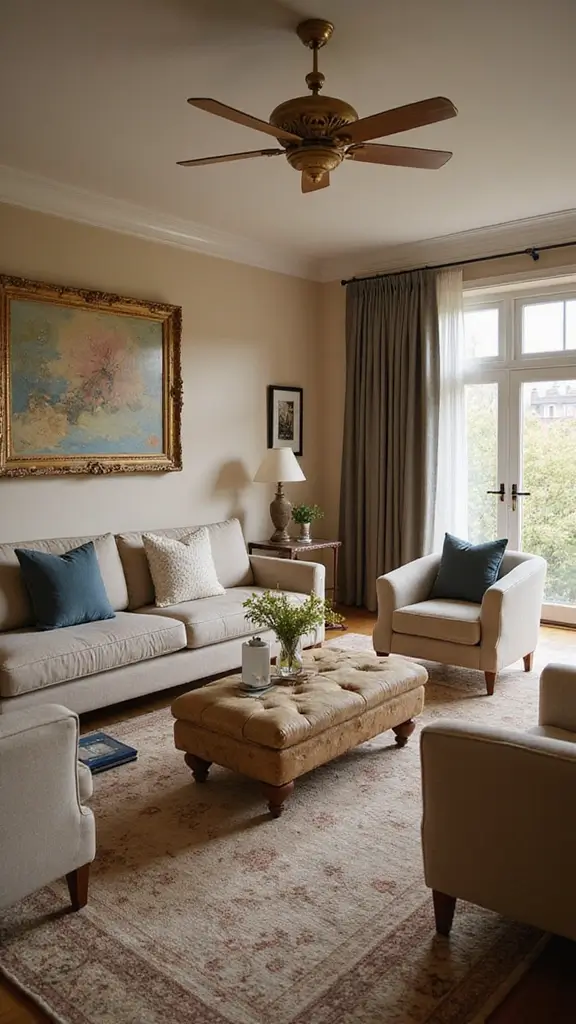
Incorporating technology into your colonial home can enhance comfort and convenience while respecting its character. Look for smart home solutions that blend seamlessly with your decor, such as smart thermostats, lighting, or security systems. These modern updates provide functionality without detracting from traditional aesthetics.
For instance, consider installing Polk Audio RC85i 2-way premium in-wall 8″ speakers. These built-in speakers are perfect for damp and humid placements, making them an excellent choice for spaces like the kitchen or bathroom. Their paintable grilles allow them to blend into your home’s design, maintaining the colonial charm while enhancing your audio experience.
You might also think about utilizing hidden charging stations for devices or emphasizing energy-efficient technologies. This thoughtful approach allows you to enjoy the benefits of modern convenience while upholding the integrity and charm of your colonial home.
40. Celebrate the Mix of Styles

Celebrating the blend of styles in your colonial home can create a vibrant and dynamic environment. Mixing various decor influences—be it traditional, modern, or even eclectic—allows for a unique narrative that reflects your personal taste. Look for pieces that resonate with you, regardless of their origin. For example, incorporating a vintage colonial dresser such as the T4TREAM farmhouse 6 drawers dresser can beautifully juxtapose against modern art, creating a conversation piece that enhances both styles. This antique white dresser, with its rustic charm and natural texture, not only offers ample storage but also adds a touch of history to your space.
To achieve a harmonious blend, seek balance by maintaining a cohesive color scheme that ties everything together, allowing for a seamless flow. Curating a mix of styles encourages exploration within your decor, making your home feel alive and personal. This approach invites creativity and individuality, showcasing a home that is truly one of a kind.
41. Reflect Personal Values with Sustainable Choices

Sustainability should be at the heart of your colonial home design. Choosing eco-friendly materials and practices reflects not just style but also your values. Opt for furniture made from reclaimed wood, organic textiles, and non-toxic finishes to ensure your decor is as sustainable as possible.
When it comes to lighting, consider using energy-efficient LED light bulbs. These bulbs are not only long-lasting and reduce energy consumption, but they also emit a warm, soft light that complements the traditional aesthetic of a colonial home. By using these bulbs, you can lower your energy bills while making an eco-conscious choice.
Look for energy-efficient appliances and fixtures that reduce your environmental impact while still being stylish. Also, consider implementing rainwater harvesting systems or solar panels for a truly eco-conscious approach. This commitment to sustainability creates a home that feels good not just aesthetically but also ethically. By integrating these practices into your design, your home becomes a sanctuary that reflects your values beautifully.
42. Foster Community with Shared Spaces
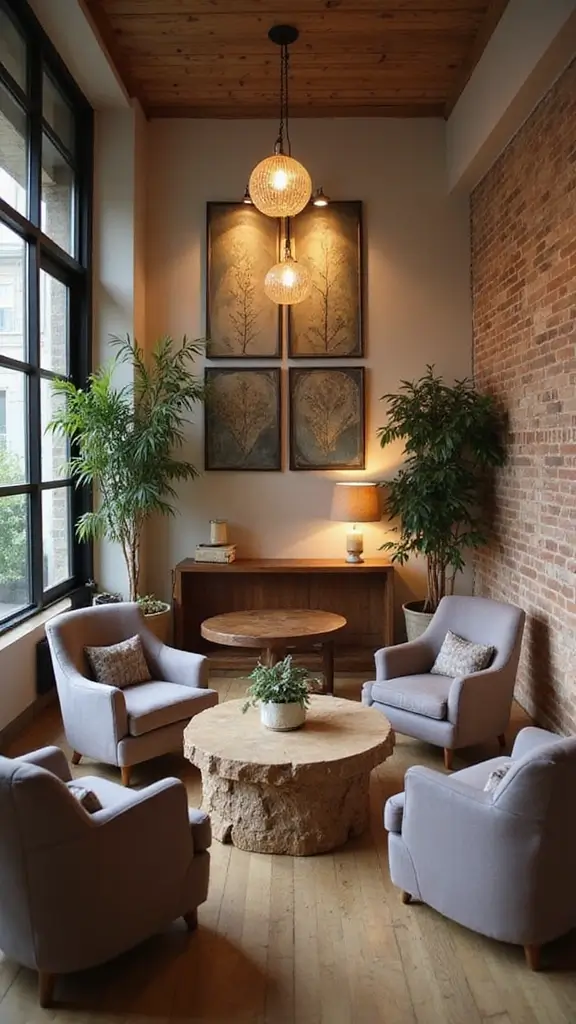
Creating shared spaces within your colonial home fosters community and connection among family and friends.
Design areas that encourage gathering, like a large dining area or a cozy lounge that invites conversation. Incorporate comfortable seating, ample table space for games or meals, and even entertainment elements like bookshelves or media centers. Flexible furniture arrangements allow for easy adaptation to various occasions, promoting interaction and togetherness. Think about using natural materials and comfortable designs in these spaces, encouraging guests to relax and connect. By fostering community through design, your home transforms into a hub of warmth and hospitality, making it a cherished gathering place for everyone.
Conclusion
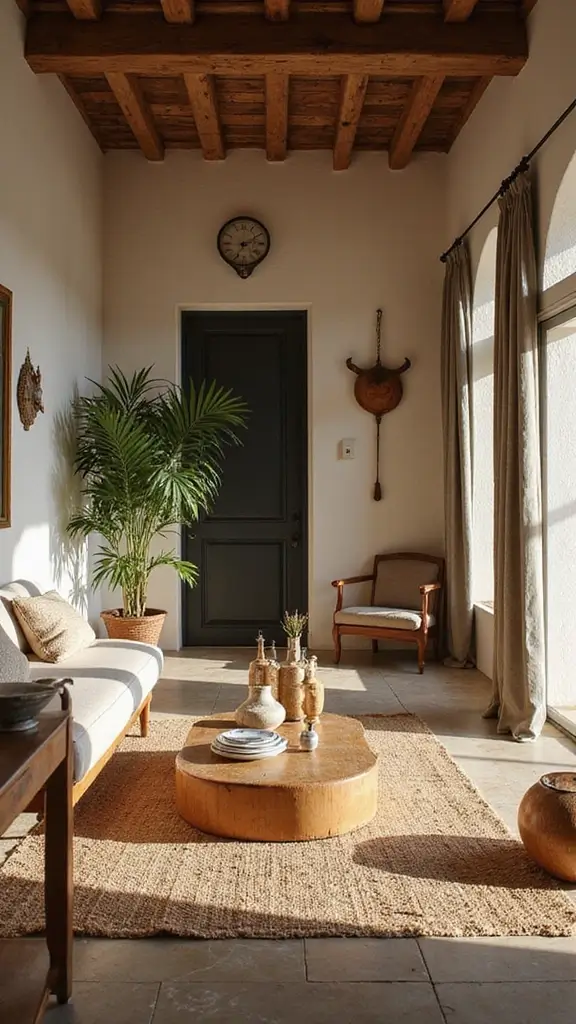
Incorporating these 42 ideas into your colonial house interior design can create a unique blend of the old and the new, transforming your home into a warm, inviting haven.
By focusing on sustainable practices and thoughtful design choices, you can cultivate a space that honors its rich history while embracing modern aesthetics.
From vintage furniture to eco-friendly materials, every detail contributes to a home that reflects your style and values beautifully.
Note: We aim to provide accurate product links, but some may occasionally expire or become unavailable. If this happens, please search directly on Amazon for the product or a suitable alternative.
This post contains Amazon affiliate links, meaning I may earn a small commission if you purchase through my links, at no extra cost to you.
Frequently Asked Questions
What are the key elements of colonial house interior design?
Colonial house interior design beautifully merges traditional elements with modern touches. Key elements include vintage furniture, rustic accents like wooden beams and stone fireplaces, and a color palette that combines historical hues with modern neutrals. Incorporating these aspects creates a warm and inviting atmosphere while honoring the home’s history.
How can I incorporate sustainability into my colonial home decor?
Sustainability can be seamlessly integrated into your colonial home decor by choosing eco-friendly materials and practices. Opt for vintage furniture to reduce waste, use natural paints with low-VOC options, and select sustainable flooring materials. These choices not only enhance your home’s style but also reflect your commitment to the environment.
What types of vintage furniture work best in a colonial home?
When decorating a colonial home, look for vintage furniture that showcases craftsmanship and unique character. Pieces like antique dining tables, classic armoires, and vintage chairs can add charm. Choose items that complement the architectural style of your home to create a cohesive and inviting space.
How can I effectively blend modern and traditional styles in my colonial home?
To blend modern and traditional styles in your colonial home, start by integrating transitional furniture that combines classic and contemporary designs. Use modern lighting fixtures alongside traditional decor, and mix textures and colors thoughtfully. This approach creates a dynamic and visually interesting environment that respects both styles.
What are some practical tips for creating a cozy reading nook in a colonial home?
Creating a cozy reading nook in a colonial home can be delightful! Use sustainable materials for furnishings, like a reclaimed wood bookshelf or a comfy chair. Add layers of textures with throws and pillows, and ensure good lighting with a mix of modern and traditional lamps. Position your nook near a window to enjoy natural light and views, making it a perfect retreat.

